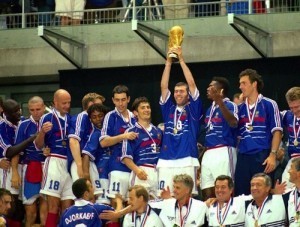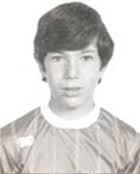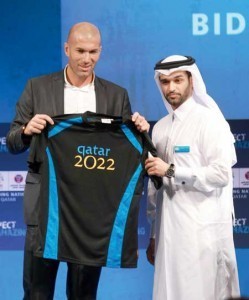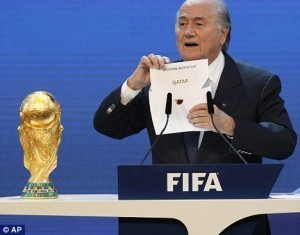Laurent Dubois's Blog, page 68
March 30, 2015
La selección mexicana se vuelve internacional
Hace veinte anos solo habían dos jugadores de la selección mexicana que jugaban en equipos internacionales, pero actualmente los miembros de la selección juegan en 16 equipos diferentes en cinco países diferentes. Anteriormente en México la gente prefería que los jugadores no jugaran en equipos internacionales y que jugaran en la liga nacional. Sin embargo, en los últimos años esta mentalidad ha cambiado mucho.
Por ejemplo, jugadores como Andrés Guardado y Jonathan dos Santos han jugado lo doble de sus partidos en Europa que en México. Anteriormente, la liga mexicana era muy buena pero en los últimos años se ha quedado atrás de las ligas europeas que se consideran las mejores del mundo. Por ejemplo, el Chicharito Hernández juega para el Real Madrid y Andrés Guardado juega para PSV Eindhoven.
Curiosamente, la selección mexicana se ha vuelto muy popular en Estados Unidos y desde febrero del 2010, juega el 60% de sus juegos amistosos allí. Sin embargo, a muchos mexicanos no les gusta esta situación nueva porque ahora muchos de los hinchas solo pueden ver a sus jugadores favoritos en la tele en vez de en vivo.

Bigger In Texas
Between #IBELIEVE trending across social media and poolside watch parties in full swing, soccer spirit was infectious and nearly unavoidable this past summer in the United States. Reverberations of this fever continue to draw attention to and interest in the future of American soccer. Certainly in Texas.
The most recent edition to Texas’ collection of large, expensive endeavors is MoneyGram Soccer Park.It replaces an old landfill. The complex sits in Northwest Dallas, and includes nineteen fields. Taxpayers contributed 34 Million dollars to the project.
Its most important function will be to host the elite Dallas Cup tournament. The 36-year old showcase draws youth talent from all over the globe. In fact, the international importance to the Cup’s prestige may have inspired the construction of MoneyGram Park.
According to Dallas Parks Director Willis Winters, “When you have a tournament with teams traveling to your city from around the country or overseas, they’ve got to be guaranteed they can play their games.”
MoneyGram was built to host international stars, not just encourage domestic ones-of which there are fewer. Still, MoneyGram will bring more soccer to the U.S.-they just plan to import it.
This strategy is reflective of a popular stance in the U.S. that seeks to poach talent from abroad. 11 members of the U.S. 2014 World Cup Team are immigrants. David Beckham’s move to Los Angeles helped boost Major League Soccer (MLS) into cultural relevance, and rumors of Cristiano Ronaldo leaving Europe for the U.S. would surely have a similar effect.
Players visiting from abroad will likely provide brilliant entertainment and revenue for Dallas’ MoneyGram. Yet this model for U.S. soccer is not as sustainable as inbred talent. It also leaves a bitter taste in the mouths of purists who envision an national core of players who Americans would more fully see themselves in. However, this plan would take far longer, and Americans have never had much patience for mediocrity. MoneyGram serves as an example for the prevailing approach.
Zinedine Zidane: La race dans le foot
Apres avoir lu 8 juillet 1998 écrit par Lilian Thuram et le commentaire écrit par Tomas sur ce livre, je suis inspiré d’écrire un poste assez similaire sur un autre membre de cette équipe : Zinedine Zidane. Pour ceux qui ne savaient pas les détails de la Coupe du Monde en 1998, il était l’événement la plus célébré dans l’histoire du football française. La coupe s’est passé dans la France et l’équipe de la France était très talentueuse avec des joueurs comme Thuram, Zidane, Henry, et Viera, mais aussi très diverse. Thuram a des origines Guadeloupéens, les parents de Zidane sont des Algériens, Henry a des ancêtres qui viennent des Antilles, et Viera est sénégalais. Cette équipe qui a des racines multinationales a gagner la coupe du monde pour leur nation, la France, sur son propre sol.
Zinedine Zidane, probablement le jouer le plus important pour cette équipe français, est fière de ses origines Algériens. Né aux immigrés Algériens dans un banlieue de Marseille, Zidane a commencé à jouer avec un ballon de foot à l’âge de deux ans. Comme Professeur Dubois a mentionné dans notre lecture de mardi, les banlieues sont des régions à l’extérieur des grandes villes qui sont assez pauvre et habiter par un grand population des immigrants. Dans le cas de Zidane, il y aurait un cour où les enfants se sont réunis à jouer au foot. Il était dans ce petit cour où Zidane a cultivé son style technique et créatif.
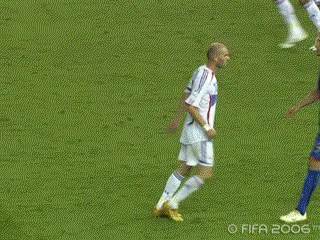
Pendant sa carrière, il maintien son héritage Algérien dans son personnalité sur et hors du terrain. Zidane est un des joueurs pour l’équipe national française qui était critiqué pour ne pas chanter l’hymne nationale française, la Marseillaise, avant des matches. Oui, Zidane est né en France est un citoyen français, mais peut-être cette acte montre son fierté a ses racines Algériens. Aussi, peut-être le moment le plus connu de sa carrière où il a donné un coup de tête à Marco Materazzi était enveloppé avec la tension raciale. Des mots vulgaires sur son héritage et famille Algérienne ont provoqué cette infamie, qui a abouti à la perte de la coupe du monde pour la France en 2006.
Plus récemment, Zidane était le porte-parole pour l’offre d’avoir la Coupe de Monde 2022 au Qatar. Ce rôle public lie Zidane au monde Arabe et une façon avec laquelle Zidane peut montre sa fierté pour ses racines arabes en promouvant la croissance du football, le sport qu’il aime vraiment. Comme le football continue à développer et les cultures du monde continu à mélanger, il sera intéressant de voir quel rôle la race joue dans le sport.
He’s Back!
One of the greatest players the world has ever seen, Ronaldo Fenômeno (the original Ronaldo), will be returning to the soccer field this year. Ronaldo had an incredibly victorious 18-year career. In Brazil’s National Team, he won the World Cup twice (1994 and 2002), along with reaching the Finals in 1998. In Europe, he once formed the starting lineup of great teams, such as PSV Eindhoven, FC Barcelona, Internazionale, Real Madrid and A.C. Milan. One interesting side note is that he played on both teams of two different sets of rivalries: one in Spain and the other in Italy. In addition, he won numerous individual trophies, including FIFA’s World Best Player in 1996, 1997 and 2002 and the Ballon D’or in 1997 and 2002.
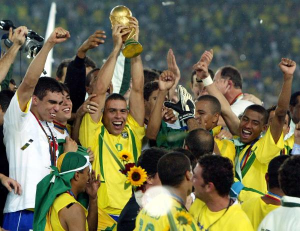
Ronaldo celebrating after winning the World Cup in 2002
Towards the end of his time at Real Madrid (around the year 2006), Ronaldo began to gain a lot weight, deeply affecting his game. Known for his speed and rapid ability to move past defenders, Ronaldo’s extra weight caused him to slowly lose his starting position in Real Madrid, until he finally left the club during the 2006/2007 season. He then joined AC Milan where he discovered that he had hypothyroidism, what doctors believed was causing his weight gain. Despite numerous diets, exercise plans and recovery periods, Ronaldo never fully lost all of his extra weight. Plus, he also suffered many injuries in the last years of his career. As a result, his game was never the same. However, he remained an excellent player with game-changing ability, as seen when he won 2 titles for Corinthians in 2009 before finally retiring in 2011.
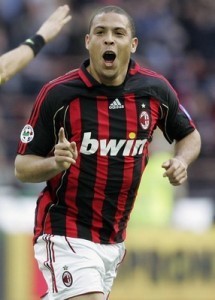
Ronaldo with A.C. Milan showing signs of weight gain
After his retirement, Ronaldo remained in the world of soccer, but now as an investor. He started the company 9ine, which is responsible for the rights of many famous players, including Neymar. In 2012, he purchased the team Fort Lauderdale Strikers, currently a member of the North American Soccer League. In 2014, he was a commentator for Globo (Brazil’s largest TV Network) during all of Brazil’s games in the World Cup.
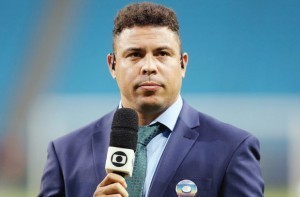
Ronaldo as a TV commentator during the 2014 World Cup
This year, Ronaldo has announced that he is returning to the pitch with his team, the Fort Lauderdale Strikers. As a 38-year old, Ronaldo has stated that soccer in the US is evolving at rapid speeds, and that he sees this as a great opportunity for the team and for himself. He’s also said to Brazilian networks that he wants to get back to training, and hopefully help his team reach the NASL’s final. When asked why he decided to be the team’s President and not Manager, he told reporters that he believes managing 30 players who think differently is too hard. Instead, he can show them how he won throughout his career by being involved as the team’s owner.
Only time will tell whether Ronaldo actually makes it onto the pitch. Given his numerous problems with his weight and past injuries, it wouldn’t surprise me to see him only play a few minutes in a match, mainly as a publicity stunt to attract attention to his team and to the NASL. Not that that’s a bad thing however, as the increased attention would certainly lead to the NASL’s growth.
March 28, 2015
Public Money for Private Stadiums?
On Wednesday, Minnesota United was officially announced as an expansion side into Major League Soccer. The franchise looks to build a 20,000 seat stadium from scratch; however, the Minnesota Governor stated that Minnesota United and Major League Soccer will not be receiving public money for their private stadium [1]. Minnesota Democrats and Republicans came out in support of the governor’s decision. Ironically, a stadium under construction for the Minnesota Vikings of the NFL is receiving $498 million dollars of taxpayer money [2]. This seems to be the norm in the current sports atmosphere in the United States, as the St. Louis proposed a new stadium that would be financed by $400 million of public money and Wisconsin is planning to give $220 million of public bonds to the Milwaukee Bucks [3]. Why does this happen? The simple justification would be that stadiums provide an economic boom to a region by hosting events throughout the year. Proponents state that stadiums provide some construction jobs, some permeant jobs, and give local businesses a boost in visibility. However, this does not seem to frequently be the case. Robert Baade performed a statistical test to see if a new stadium or sports team was a boon to the local economy, and in many cases, there was no statistical economic difference before and after the stadium was built or the team was formed [4]. It turns out that many fans spend money at or around the stadium that would elsewhere be spent in or around the city.
If that is the case, then why do we still subsidize these stadiums? Perhaps one reason is that the taxpayers value their sports teams. Americans spend a considerable amount of time on Sundays watching the NFL and rooting on their team, and the last thing many of them would want is for their team to be gone. However, this is exactly the case in Saint Louis, where the Rams are threatening to move to Los Angeles unless the city increases public funding to a new stadium. Many other underserved markets, such as Buffalo, Jacksonville, and Oakland, have threatened to move to other cities, placing the ball in the taxpayer’s court. The last thing many Saint Louis Rams fans want is to lose their team, so if that means increased public funding for a new stadium, that is one unfortunate sacrifice that one would make.
The franchise system is a major player for the usage of public funding in the US. Instead of clubs with local roots and history, franchises move around to more desirable locations relatively consistantly. Some examples include the Seattle Supersonics (NBA) moving to Oklahoma City, the original MLS San Jose Earthquakes moving to Houston, the Atlanta Thrashers moving to Winnipeg, and the old LA Rams of the NFL moving to Saint Louis. As seen, this is frequently the case in the North American sports landscape; however, it is not so much the case in Europe. One notable example is when Wimbledon FC moved roughly sixty miles to Milton Keynes in 2003. However, that was a lengthy process and it is believed that the FA would not allow another team to move a significant distance from its current home. For example, when Arsenal left Highbury, their new stadium, Ashburton Grove, was adjacent to its old. Similarly, Tottenham are currently constructing a larger stadium to replace White Hart Lane, and again, it is on an adjacent land parcel. Another similarity that both of these stadiums have is that no public money was used in building them, and that these stadiums were valued at 400 million pounds. Why is public financing so common in the US for stadiums, but not in England? There are no doubt different political climates; however, another reason also rises especially after the MK Dons fiasco. It does not seem feasible that teams will be able to significantly relocate, which means that they cannot credibly threaten to relocate, meaning that the cities do not have any real incentive to fund a new stadium. In the US, a franchise can move after a certain number of league owners approve it, however, the FA does not appear as if they will let any clubs relocate, which ends up saving the tax payers a significant amount of money.
[1]http://minnesota.cbslocal.com/2015/03...
[2]http://www.startribune.com/local/minn...
[3]http://reason.com/reasontv/2015/03/17...
[4]http://news.heartland.org/sites/all/m...
Cover image from sodahead.com
March 27, 2015
Will FIFA Regret a Qatar World Cup?
Since FIFA has confirmed that the 2022 World Cup will be held in the winter with the final scheduled for December 18th, many questions have been raised about what will this mean for the soccer world.
When Qatar initially launched the bid to host the 2022 World Cup in 2009, there were already a lot of concerned evaluation reports about the temperature conditions and safety conditions for both players and laborers. Even with these reports, FIFA chose Qatar to host the World Cup in December 2010. Since this decision, allegations about bribery and concerns about human rights abuse has defined this specific World Cup. With allegations mounting against the organization, FIFA hired an outside attorney, Michael J. Garcia, to investigate the ethics involved in the selection process. Garcia submitted a 350 page long report that was never made public. It seems that FIFA has issued a summary that was instead “erroneous and incomplete.”
While an independent committee or investigator can not spur reform, perhaps money will be a better motivator. Moving the World Cup to the winter will be costly and may pave the way for changes in future revenue streams that may make FIFA reevaluate the next selection process.
For instance, FIFA had accepted bids for American broadcasting rights to the 2022 World Cup from Fox in 2011. However, Fox made its bid for the summer time, as the winter time would cut into its deal with the very lucrative NFL broadcasts. To make up for this, FIFA has allowed uncontested bids from Fox for the rights to the 2026 World Cup, which means that prices for the tournament are far lower than if there was an open bidding process with rival networks such as NBC or ESPN. Given that FIFA’s budget relies heavily on television broadcasts (43% of their revenue comes from television rights), this discounted fee may set a lower benchmark for future World Cup television rights bids in the US, which would cost FIFA millions of dollars in future revenue.
Additionally, one can not overlook the disruption the winter World Cup will cause for the European domestic club football schedule. National leagues, such as the EPL, La Liga and Bundesliga will have to redo their entire 2022-2023 season schedules. This may mean fewer broadcasted games in the FA Cup or the Capital One Cup, which would lead to costly renegotiations with television broadcasting companies. The head of the European Club Association, Karl-Heinz Rummenigge, has stated, “The European clubs and leagues cannot be expected to bear the costs for such rescheduling. We expect the clubs to be compensated for the damage that a final decision would cause.”
Lastly, FIFA also pays clubs to release their players for the World Cup. Given the unprecedented change in the 2022 World Cup, FIFA has already announced that it will agree to a $209 million compensation deal each for the 2018 and 2022 World Cups. This deal is substantially larger than the one constructed for the 2014 World Cup, which only cost FIFA $70 million. As with the deals with Fox network, this agreement can set a benchmark that will be very hard to change, which would cost FIFA millions in compensation deals for the future.
Money is always a strong motivator when it comes to profiting organizations. With the potential loss of hundreds of millions of dollars due to the Qatar World Cup, perhaps FIFA will think more strongly about actually reforming its culture.
Sources:
http://www.newyorker.com/news/sportin...
http://www.fifa.com/mm/document/tourn...
¿Por qué está luchando el equipo americano?
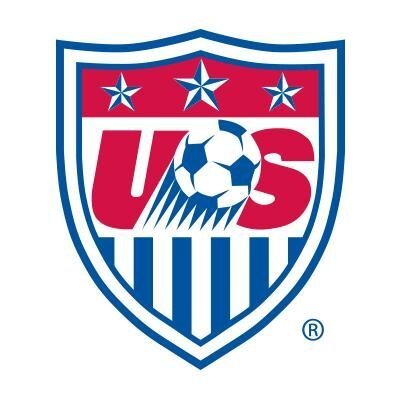
Después de la Copa Mundial, el equipo nacional de los Estados Unidos solamente ganó dos de cada ocho partidos. La noche del miércoles, los americanos perdió a Dinamarca después de conduce el juego por mucho del partido. Jurgen Klinsmann, el entrenador por los estados unidos, utilizó muchos jugadores en el partido, pero nunca se hizo una diferencia grande. En un articulo de Goal.com, Ives Galarcep dijo que jugadores como John Brooks y Fabian Johnson no jugó a su potencial, y por eso, el selección americano cayó plana. Otros artículos se criticaba los decisiones de Jurgen Klinsmann. Él hizo unos sustitutos interesantes, como Alfredo Morales para Alejandro Bedoya. Klinsmann utilizaba Bedoya en el centro del campo, y no le utilizaba en el exterior, su posición preferido.
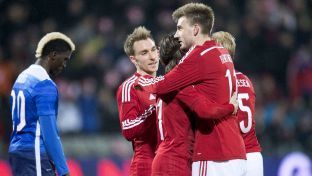
Junto de las preguntas sobre el entrenador del selección americano, habían preguntas sobre el estilo de jugar. El equipo de los Estados Unidos le gusta utilizar el “balón largo” para generar delito. Klinsmann dijo que el equipo se movería más a pasar para crear delito, pero cuando el equipo ha tratado de pasar, no ha funcionado bien. Esta problema es una manifestación de los diferentes estilos de los Estados Unidos y el Europa. Klinsmann entrenaba por Bayern Munich antes de tomar el trabajo de los EE.UU, y es de Alemania. A causa de su experiencia europea, Klinsmann quiere que el equipo americano jugar en el estilo europeo en lugar de limitarse a lo que funciona para su equipo. Creo que es necesario crear un estilo de juego único en América con el fin de atender a las habilidades de nuestros jugadores y un llamamiento a los aficionados americanos. La selección juega contra Suiza el martes con la esperanza de un mejor resultado.
March 26, 2015
Extending Hope – A Home on the Field
Paul Cuadros’ A Home on the Field is an inspirational retelling of the author’s three years as the soccer coach at Jordan-Matthews High School in Siler City, NC. His players, most of whom were Hispanic immigrants from Central and South America, were struggling to prosper in the American football-crazed town before he arrived.
When Cuadros, who went to North Carolina to study the growing Hispanic populations in the South, approached the school’s principal about starting a team, he acknowledged that Cuadros’ idea was a good one, but he did not foresee any long-term viability for the program. Besides the costliness that surrounded establishing a program, the principal mentioned that most of the Hispanics at the school, who would make up the core of the team, “really do not understand being eligible to play a sport” (33). Cuadros persisted, and eventually received support from the school district’s superintendent to start a team with him as the coach.
Cuadros structured early practices around teamwork and always finished practice with a game that was a team favorite: cascarita. He began to realize, however, that the players, though they wanted it to be, could not keep soccer as a high priority. Many players were forced to work jobs in order to help support their families, so practice attendance numbers fluctuated. In the book, Cuadros wrote that the type of work did not matter, only that “[one] was working and making money” (76).
The beginning of the inaugural season arrived, and Cuadros, through his position on the board of a local soccer league, was able to acquire new uniforms for the boys to wear. Cuadros wrote that the boys “were giddy with excitement” (77) and were finally able to feel like a part of their school, for “they were no longer on the sidelines watching teams compete as Jets…they were now Jets themselves” (78). Although they found success on the field, home lives for the players were never easy. For instance, Cuadros wrote about a player named Indio who called Cuadros one night stating that he would have to go back to Mexico to tend to his ailing grandmother. Cuadros implored Indio to remain in North Carolina, citing that he “might never get back to finish school” (196). After Indio’s father spoke with Cuadros to alert him that he would be traveling back to Mexico but that the rest of his family would stay in Siler City, he, with the help of Cuadros, wrote a letter for Cuadros to give to his family in case he never returned. Cuadros mentioned that he placed the letter on his bookcase, and “it sits there to this day” (197).
The culmination of Cuadros’ and the team’s hard work came when they won the state championship during his final season at the helm. In an almost stunning turn of events, supporters for the Jordan-Matthews soccer team came out in troves. Although just a mere three years earlier the idea of a soccer team in the town was essentially unheard of, Cuadros recalled that “there were black, white, and brown students…[and] teachers…to support their kids” (250). In the book’s final passage, Cuadros conjures up an image of the trophy case at the high school that houses the state championship trophy and a picture of the team. When Hispanic students pass by and glance at the case, Cuadros writes, “they see themselves with the promise of a better future” (264).
Una visita al estadio del Philadelphia Union
El estadio como representación del equipo y de la cultura
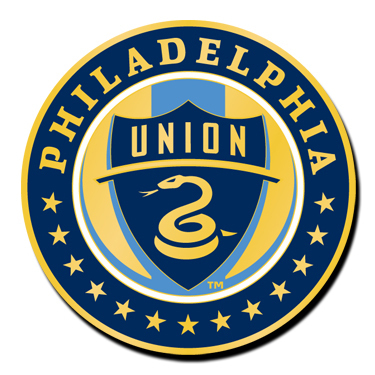
El Philadelphia Union fue establecido en 2008
Mi primera (y sola) experiencia con un partido profesional de fútbol pasó cuando tenía dieciséis años. Una prima me invitó venir para un partido entre el Philadelphia Union y el San Jose Earthquakes. No sabía que esperar porque no era una fanática del MLS; prefería las ligas de Europea, y estaba de acuerdo con la opinión popular que el fútbol del MLS es de cualidad baja. De verdad, ni siquiera sabía que había un equipo de San Jose.
Conducimos al estadio desde su apartamento en Philadelphia, yendo al sur. Me sorprendió aprender que el estadio del equipo no está en Philadelphia:
“La tierra era mas barato aquí” explicó mi prima.
Prontamente salimos de Philadelphia, y entramos el autopista, y salimos por una vía de acceso diez minutos luego. Inmediatamente cambió la escena. Pasamos un casino y rápidamente nos encontramos en el centro de una ciudad menor.
Mi prima me dio que la ciudad se llama “Chester”. Cubierto en grafiti, no podía encontrar ni una tienda ni un comercio que pareció abierto, y la infraestructura y las casas parecían a los de un país más pobre. Entonces, después de pasar a través de esta ciudad triste, entramos un estacionamiento muy grande. En el fondo estaba situado el estadio. En contraste con la ciudad desolado, el estadio fue muy nuevo, construido solo hace pocos años. Las luces del estadio y la emoción de los fanáticos entrando el estadio fueron poco extraño después de ver Chester, que luego aprendí era la ciudad segunda más peligrosa de la nación.
La experiencia en el estadio fue interesante. El estadio fue relativamente pequeño, especialmente si se compara con los estadios del fútbol americano, como el de los Eagles en el sur de Philadelphia. A pesar de esto, el estadio no estaba lleno.
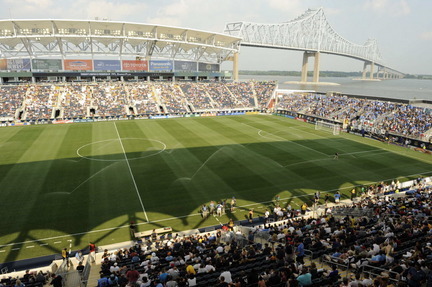
PPL Park, el estadio del Philadelphia Union
Sin embargo, la emoción de los fanáticos fue evidente. Aún antes del comienzo del juego, fueron cantos y ovaciones constantemente. Los fanáticos, incluyendo mi prima, gritaron todos los insultos que podían imaginar, y actuaron casi locos. Una sección fue dedicada para el club oficial de fanáticos—llamaron “los Hijos de Benjamin”. Ellos dirigieron cantos y redoblaron tambores masivos. Había visto ese tipo de emoción en la televisión durante la Copa del Mundo, y a veces en videos de la liga española, pero nunca lo había visto con el fútbol en los estados unidos. Después de todo, no somos un país de fútbol.
En una manera, no parecía totalmente auténtico. El equipo durante ese año fue entre los peores de la liga, y jugaban en un estadio en una ciudad pobre en un país que prefiere baloncesto. Verdaderamente no es una situación buena para el éxito del equipo, y parecía que los fanáticos estaban esforzarles de parecer emocionados.
Mientras que consideraba todo esto, concluí que los fanáticos estaban compensando un poco. Supieron que el equipo necesitó todo el apoyo que pudiera conseguir, supieron que no hubo muchos fanáticos, y por eso intentaron de llenar el espacio—el vacío—que estaba dejado por falta de números. El club oficial de fanáticos, llamaron “los Hijos de Benjamin”, es interesante en que fue establecido años antes del equipo, y fue de vital importancia en el proceso de traer un equipo profesional a Philadelphia. Son el corazón de los fanáticos, y últimamente el corazón del equipo.
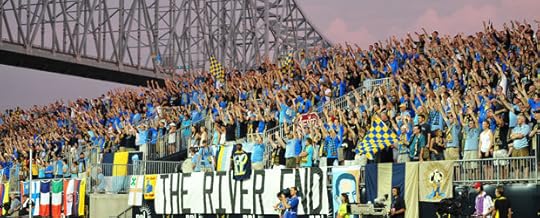
Los Hijos de Benjamin
Me parece que, porque el fútbol profesional no es muy popular en los Estados Unidos, los fanáticos no son solo fanáticos; son una parte de un movimiento. Quieren que su equipo gane, pero además, y quizá más importante, que el fútbol tiene éxito en el EE.UU.
Después de ir al partido, veo el Philadelphia Union como “underdog”, pero veo también el entero MLS así. En una manera, me hace querer ser un partidario de la liga, porque es la liga de mi país. Nunca he visto el MLS mucho antes de ir al partido profesional, pero ahora me considero como fanático. Soy fanático del Philadelphia Union, y soy fanático del MLS.
En los años recientes, la cualidad del juego de MLS ha mejorado, por mi propia evaluación. Los financieros siguen apoyar la liga, y los equipos siguen traer el talento extranjero a la liga. Algunos jugadores americanos, que previamente jugaban en Europea, han regresado para jugar en el MLS—Clint Dempsey es un ejemplo significativo. Considerando esto, y la popularidad de fútbol entre los jóvenes del EE.UU., creo que veremos el crecimiento de fútbol profesional en el EE.UU. por muchos más años.
On Gareth Bale
Gareth Bale has had a rough start to 2015. His number of goals, assists, shots per game, and shot conversion rates are down significantly from the same place last season and his struggling form is apparent to the world. To Real Madrid fans this is especially apparent, and almost 70% of fans currently believe that Bale shouldn’t be in the starting lineup for the close future. Of course it doesn’t help that Real Madrid fans are some of the harshest soccer critics in the world. Many have jeered at him, attacked his car, and even called for his departure from Real Madrid over the past few months. This is all in stark contrast to last year when Bale helped Madrid win the European Cup and The Copa del Rey last year by scoring in both and in doing so, joining the ranks of legendary Raul.

While transfer rumors have run rampant for the last several months and have focused particularly on a transfer to Manchester United, following in the footsteps of former Madrid player Angel di Madrid who transferred over to United last summer. This rumor has been exacerbated by several factors ranging from the fact that many feel that Bale would player better closer to home to the the fact that he may want his daughter to attend school in the United Kingdom rather than Spain.
However it seems more and more likely that Bale will stay with Los Blancos for the foreseeable future for many reasons. In my mind the first and foremost reason is that Bale is a superb player, and all players go through slumps at some point in their career. While this stirs up a great deal of criticism driving transfer rumors left and right, it doesn’t negate the fact that he’s a great player. Carlo Ancelotti and Florentino Perez know this, and I doubt that they would be so shortsighted as to transfer a good player going through a rough patch, especially one that was so vigorously pursued. Another major factor to consider Manchester United’s side of this rumor. Manchester United has been looking quite a bit into signing Paul Pogba, a big name, big price tag player. If they did secure Pogba it seems unlikely that their finances would be in a place to pay for another big ticket player such as Bale. Finally, we have to consider Bale, it seems unlikely that after a short dip in form he would give up on playing for Madrid, a team that he was very intent in playing for when he first signed on.
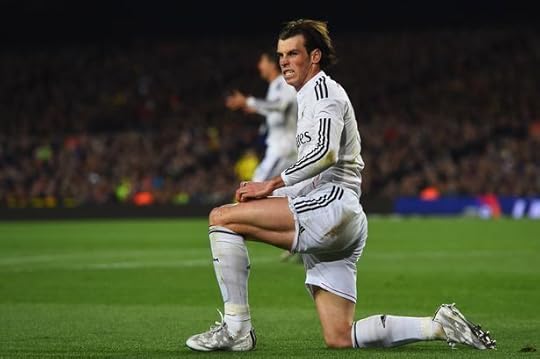
Bale after this years less than stellar clasico performance
Laurent Dubois's Blog
- Laurent Dubois's profile
- 44 followers


